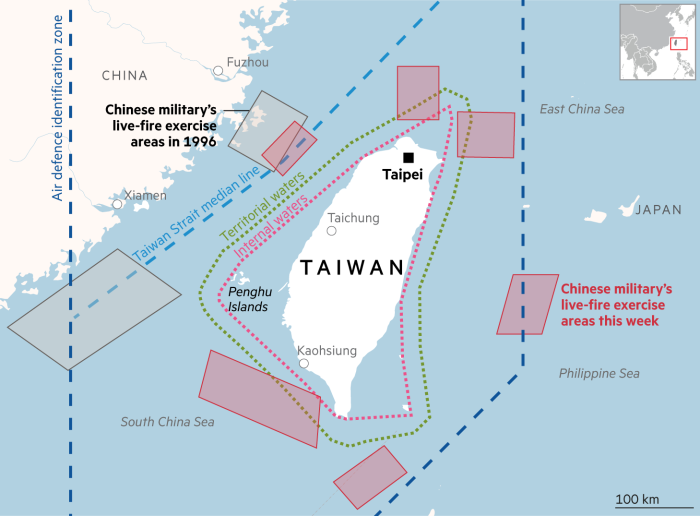
After China declared an end to its military exercises around Taiwan on Wednesday, defense experts stepped back to analyze the operation designed to punish Taipei for hosting US House Speaker Nancy Pelosi. Their main conclusion: More than a war rehearsal, the week-long activity was a deterrence operation.
“There is a narrative that what they are doing is indicative of a forceful unification of Taiwan or a blockade. But almost every element that the People’s Liberation Army communicated during the operation aligns perfectly with what they call deterrence activity,” said Roderick Lee, director of research at the China Institute of Aerospace Studies, a US Air Force think tank.
According to Beijing’s defense strategy, the PLA is willing to make some offensive moves to defend against perceived threats, but seeks to control the risk of escalation. The PLA clearly distinguishes these operations from wartime activities.
Most of the PLA’s maneuvers around Taiwan over the past week are listed as options for deterrence activity in a 2020 textbook from China’s National Defense University, including the sample of new weapons in action and changes in force distribution, as well as restricted military movements to limit the adversary. .
Taiwanese defense officials and U.S. experts say Beijing deployed a series of actions that met those criteria: seven areas were closed for live-fire drills, blocking some of the busiest flight routes and shipping lanes of the region; the PLA transported military equipment through China; fired the PHL 16, a heavy rocket artillery system unveiled at a parade just five years ago; and distributed images of China’s newest stealth fighter taking off at night.
Above all, the PLA’s deterrence manual calls for strong messages to instill fear of war in its adversary, a tool that has been used prominently in recent exercises. Several times a day, the PLA’s Eastern Theater Command released videos and images of fighters, warships and missiles, and described their activity as practicing an attack on Taiwan or denying access to American forces in the area.
The government, state media and mainstream commentators accompanied this effort with propaganda justifying China’s actions, calling for more and vilifying Taiwan and the US.
“Of course, it’s useful for them to put it all together, to have the pilots operating in the area relevant to an attack on Taiwan, at a high operational tempo and in an environment that offers a little more stress on command and control than usual,” Lee said. said “But the large-scale exercises that the PLA conducts every summer do much more to prepare them for a Taiwan conflict,” he added, pointing to regular unit-level exercises focused on amphibious landing.
Still, Taipei is learning from the episode. A move that has drawn much attention among defense officials was China’s launch of PHL 16 rockets from Pingtan Island, just off the mainland, in the narrowest section of the strait from Taiwan. “They are hinting that they can hit Taiwan directly from the coast. We knew that before, but now they have pulled out their weapons,” said a person advising Taiwan’s defense ministry.
“This means that our coastal defense strategy may not be viable. Using this [multiple launch rocket system] it would be a much cheaper and more effective way for them than missiles to hit the dispersed units of ground forces that we position to defend against landing forces,” he said.
Others challenge that conclusion, saying that to demonstrate the threat of China’s newer multiple launch rocket systems, the PLA would have had to fire at one of the closure zones off Taiwan’s northern coast to demonstrate that the missiles they had a range of over 200 km and were capable. to cover most of the island.

Taipei and Washington are also focused on the missile tests that the PLA opened the exercise with. Some missiles flew over Taipei and fell into the sea east of the island. “It’s a clue to the United States that this is how we’re going to sink your carriers,” said Shu Hsiao-huang, a researcher at the National Defense and Security Research Institute, a think tank backed by Taiwan’s defense ministry. .
Shu said it was notable that none of the materials released by the PLA on the exercises mentioned the use of the Dongfeng 26, an intermediate-range missile called the “Guam express” because it is designed to strike the US Pacific territory that hosts several forces under the command of the Indo-Pacific, or Dongfeng 17, a medium-range ballistic missile that can carry a hypersonic missile. Both are seen as essential for the PLA to impair the United States’ ability to come to Taiwan in the event of a Chinese invasion.
Compared to the 1995-96 Taiwan Strait crisis, when China retaliated against closer public engagement between top US and Taiwanese officials with missile tests, military analysts see substantial progress in the EPL’s ability to quickly ramp up a complex campaign.
“In 1996, the exercise had a preparation period of more than a week, but the preparation period for this exercise was shortened to 72 hours,” said Hsu Yen-chi, a researcher at the Council of Studies Strategic and Wargaming in Taipei. “This is the PLA’s countermeasure against the stated US goal of a week-long expedition to the Taiwan Strait. A quick surprise attack remains Beijing’s ideal plan to invade Taiwan.”
recommended

Officials and analysts believe Beijing began preparing months in advance because plans for Pelosi’s trip to Taiwan first became public in April and China began making threats about a response military soon after. But they argued that any plan for a PLA operation would have been “offloading” at that stage, and the Chinese military’s movements after Pelosi’s departure showed its much-improved rapid response capability.
Some analysts see this as a sign that the new command structure established through sweeping reforms since 2015 is working smoothly. “It’s a benchmark for the state of affairs in conducting joint operations,” Lee said.
[ad_2]
Source link


